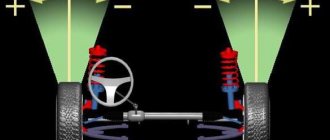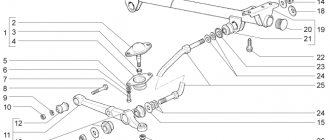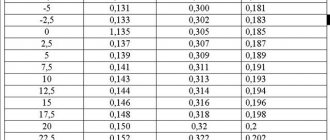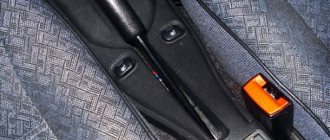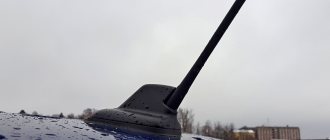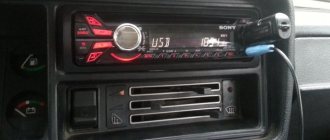For every driver, the issue of high-quality and proper operation of the car is always in the first place. When it comes to steering and its performance, you need to be especially careful and careful. Steering is one of the most important parts of any car. If the car pulls to the left, the causes of the problem must be urgently identified and eliminated. This can save you from unforeseen situations. Let's look at why a car leaves a straight course.
It should be noted that the reasons for the car pulling to the side can be practically nearby and you won’t have to look for them for a long time. But it also happens differently.
Why does the car go off course?
There are several typical faults that can cause the car to pull to the right or to the left.
And the roads, or rather their condition, are not always to blame. The most popular reasons are:
- wheel alignment;
- tire pressure;
- play in the steering;
- condition of the rubber.
Below we will look at everything in more detail.
The steering wheel pulls to the left or right - what could be the reasons?
It may seem like a daunting task to try to diagnose a car's steering system or suspension problems, but if you do it systematically, you have a good chance of finding the correct cause of such problems. We have identified the symptom of the steering wheel pulling to a certain direction, and this definitely means a problem with the suspension and/or steering, and let's look at the probable reasons why the steering wheel pulls to the side in the list below! Most of the reasons that the car is steering to the right can be determined independently by other characteristic associated symptoms, however, sometimes a particular malfunction can only be determined by a qualified auto mechanic.
It is very important, before starting to replace certain parts and components of the machine, to check all the fastenings of the nuts and bolts of the suspension elements to make sure that the steering wheel is not pulled to the side due to simple looseness of the parts. In addition, before trying to look for the cause, you need to establish the stability of the malfunction - it often happens that the car is pulled to the side due to the ruts of the road, and in this case, the main feature of the steering wheel being pulled for this reason will be that it will not only be pulled in one direction, but in different directions - depending on which side of our trajectory this track is located. Try driving on different roads, let go of the steering wheel and carefully observe whether the car always starts to pull in one direction. In addition, check whether the released steering wheel turns in the same direction on its own or whether it remains in the same position.
Rear wheel offset
If the rear wheels are offset relative to the car body, this will also lead to a situation where the steering wheel pulls to the left when driving. This often happens after poor or incorrect wheel alignment settings. What to do in this situation? Experts recommend re-adjusting the camber and toe. It is worth noting that the rear wheels are not adjustable on all cars.
You should also diagnose and, if necessary, adjust the position of the front wheels relative to the rear. If there are geometry violations, then after eliminating the problem the car will drive correctly.
Tire pressure
If your tires are not inflated evenly, this is another possible reason for your vehicle to pull to the side. It is worth checking the pressure in all wheels. If the car leaves a straight course, then the first thing to do is check the pressure in the wheels on the side where the car goes.
If the difference between the tires is at least 0.5 atmospheres, the car will definitely go off course. To eliminate the cause, it is enough to inflate the wheels so that they have the same level.
Tire condition
A common occurrence is various tire defects. So, on cars (including new ones), the tire wears unevenly. Therefore, the steering mechanism is unstable.
Also, during the operation of the car, deformations of the metal frame of the tires are possible when driving on bad roads with low pressure. In this case, there will be no characteristic beating in the steering wheel. But the car’s drift off course appears immediately.
There are also situations when a narrow part of the cord layer in a tire breaks. Most often, such ruptures occur when the car is driven on uneven roads with low tire pressure. The result is the formation of a thin strip opposite the bead of the disk inside or outside the tire.
It is necessary to check the condition of each tire. If there is a serious wheel defect or tire wear, you can solve the problem by replacing the tires. But this does not always work out, since tire prices are quite high, and this is a serious purchase. In this case, experts recommend trying to turn the old tires in the other direction. Then the flat side will be on the outside. The worse one will go inside. This way you can solve the problem of the car moving to the side and save a serious amount. But it is worth noting that some tires have an asymmetric tread. In this case, you can try to re-align and drive until the tread wears off as evenly as possible. Usually this takes from 1 to 2 thousand kilometers.
But naturally, if the wear of the rubber is large, a simple rearrangement will not be enough for a long time, and after a while the situation may repeat itself or the rubber will wear out completely.
Pulls on acceleration
Drivers often don't understand why their car pulls to the right or left when you let go of the steering wheel. Here you should remember that throwing the steering wheel is not recommended at all, even if you are moving at minimum speed. Deviation from the trajectory can also occur due to banal unevenness on the road surface.
But there are much more serious reasons why a car steers to the right and left. If everything is fine when braking, you need to check how the car will hold its course when accelerating. This is a fairly common phenomenon.
Spontaneous turns of the steering wheel when accelerating do not occur so often. But there are several main malfunctions that make this situation possible. These experts include:
- incorrect tire pressure;
- incorrectly performed wheel alignment;
- presence of damage to the tires;
- different degrees of rubber wear on one axle.
But due to some serious problems with the steering, the car pulls to the side in rare situations. Therefore, first, it is recommended to check the most common sources of problems. If they are not confirmed, then you should visit a good car service center and consult with the specialists. Specialists will conduct a comprehensive diagnosis and be able to give you an accurate answer to your question.
Unknown reasons
Unfortunately, even experienced diagnosticians sometimes cannot determine what happened and why the car behaves this way. The fact is that even serious companies allow various minor defects at the car production stage. Some of them can be detected during maintenance, but others cannot be identified. Defects associated with the car pulling to the side can be solved by adjusting the wheel alignment. This procedure costs about 500 rubles. But if the car pulls to the left, and the camber is normal, then what is the reason? We also note that this problem can occur when the suspension arms are bent. The car was in an accident or fell into a large hole at speed.
Chassis and suspension malfunctions
When mechanical problems occur, the car pulls to the side much more than from the difference in tire pressure or different tread heights. The following faults cause the vehicle to be driven away:
- Worn tie rod ends. The ball pin does not turn well in the hinge, and sometimes it simply jams. A clear sign is that the steering wheel does not return to its original position on its own, the car continues to move in an arc.
- One of the steering rods was bent as a result of the impact and became several millimeters shorter. The toe angle of the front wheels is disrupted, tire wear on the affected side is accelerated, and the car is driven in the appropriate direction.
- The ball joint is stuck. The pin rotates around its own axis with great difficulty and does not allow the wheels to turn freely. At the last stage of wear, the hinge emits a loud creaking sound - a harbinger of final failure.
- The separator of one of the wheel bearings is destroyed. The balls scattered and ground into metal shavings, blocking the rotation of the hub. The car pulls towards the jammed wheel.
- After repairing the suspension, the alignment procedure was performed incorrectly or not done at all.
Advice. Not all reasons for a vehicle's deviation from a straight line are so critical. More prosaic moments also happen, for example, the bolts holding the hub have come loose. Hence the recommendation: before troubleshooting, check the reliability of the threaded connections of the suspension, chassis and steering rods.
How to diagnose these faults in a garage environment:
- Drive the car into an inspection ditch and check the steering rod ball pins. You need to grab the rod with your hand and try to rotate it around its axis. A serviceable hinge will allow it to rotate with little tension, a loose one will allow it to rotate very easily, and a jammed one will not allow it to rotate at all.
- The bent rod is also easy to notice from the inspection hole. The part must be replaced immediately, you can drive further only after adjusting the camber.
- To check the rotation of the ball joint, it is advisable to hang the front of the car and turn the wheels manually. Option two: diagnose play by alternately rocking the wheels.
- Wear and destruction of the bearing does not occur silently - the phenomenon is accompanied by a hum and grinding noise while the vehicle is moving. To check for damage, hang the wheel from the “noisy” side and spin it by hand. A broken bearing will immediately stop rotating or start grinding.
The bearing, which is in the initial stages of wear, moves the machine off the trajectory slightly. It is easier to guess about a malfunction by the buzzing sound. The damaged element is replaced immediately at the nearest car service center or on your own. If after replacement the car continues to deviate from a straight line, look for a breakdown elsewhere.
You can replace the rods and steering ends yourself (you will need a special puller), but you cannot drive further without adjusting the toe on the stand. By squeezing out the ball pins or unscrewing the tips, you will inevitably break the old settings.
The car goes away when accelerating
Front-wheel drive cars can move to the side if so-called spacers are installed on the front springs.
In this case, the steering wheel will be pulled in the direction where the drive is longer. The axle shaft operates at a certain angle, and on a longer drive the centrifugal force will be higher. This is why the car pulls to the left when accelerating.
On domestic VAZ cars, the situation when the car goes off course is built into the manufacturing process by default. This can only be influenced by replacing the longitudinal inclination of the shock absorber strut.
Why does the steering wheel pull to the side when braking?
But if the symptom of steering wheel slip appears exclusively during braking, then, most likely, the brake pads are jammed on the brake disc or drum. This is also easy to understand - drive at a normal pace for 10-15 minutes, periodically working the brake pedal - use your brakes, and then stop and check how hot the brake discs are on the front wheels - be careful not to get burned: do not touch the calipers immediately after stops, and first splash a drop of water into them or just spit - if the water (saliva), barely touching the surface, boils (provided that you did not brake for a long time “to the floor”), then this means that the pads are stuck in the caliper while pressed position towards the brake disc. In this case, most likely, such a problem will be observed only on one side of one specific wheel of the car. Also, check the brake pads themselves for uneven wear. But to eliminate this malfunction after identifying it, you will again have to contact a specialist auto mechanic.
Tires and wheel alignment
The car owner changes the tires, then the wheel alignment is adjusted. As a result, the car still leaves, but before installing new tires and adjusting the angles, everything was fine. What's the matter?
The reason is that previously the slip created by the tires was compensated for by incorrect wheel alignment angles. Once adjusted, this balance no longer exists. Hence the problems. This is why the car pulls to the left after changing wheels.
Experts recommend checking how tires affect car steering. To do this, swap the front wheels. If the car starts to move in the other direction along with the tires, then the causes of the malfunction are directly related to them. You can solve the problem by installing one of the front tires in reverse - so that the inner part now becomes outer.
If directional tires are installed, then the wheels are temporarily swapped to make sure that the problem is with the tires. If the car pulls to the left after replacing the wheels, then install the front ones back, and then search for a pair on which the car will go on a straight course. This problem has now become especially common on domestic tires. It's all about the quality of production - you can observe various violations of the rubber frame, which causes deformations.
If the chassis has been diagnosed, but the car pulls to the left, the reasons may lie in the fact that only the front axle of the car has been adjusted. You need to make sure that everything is fine with the rear axle too. But more often it happens differently - there are deformed parts on the rear axle. Sometimes even camber adjustment specialists cannot notice these defects.
Reason #7. Steering rods and ends
This part of the steering keeps the wheels in the same direction during straight-line motion. If the steering tips or rods are loose, then the wheels begin to wobble in a chaotic manner, and the car pulls to the side or generally “sausages” at random. You can also check this defect at home. But, in addition to the jack, you will also need an inspection hole or overpass. As a rule, in a suspended state, fairly worn steering tips and rods reveal themselves very easily - in good condition, if you tug on them, they remain motionless. Loose ones, accordingly, dangle.
By the way, some reasons why the car pulls to the side lead to the appearance of other reasons described here. So, for example, if the steering is loose, then very quickly this will cause uneven wear of the rubber, and will also accelerate the wear of serviceable wheel bearings. It’s the same with wheel alignment – one causes the other (wear of the tread, bearings, steering).
Why are installation angles disrupted during operation?
Probably every car owner has noticed that over time the car changes its behavior. So, even if the car did not get into an accident, if the owner drove very carefully, then sooner or later the car will begin to move away from straight-line motion.
This happens due to subsidence of elastic parts in the suspension mechanism. These are springs, rubber bands, body parts. Also, over time, gaps appear and accumulate in the hinge joints in the suspension. When these gaps add up, a quite noticeable change in angles is formed.
The angle also changes due to the aging of the car body. He experiences bending and torque. This leads to the fact that the geometry gradually changes, and the wheel alignment angles increase. As a result, the car pulls to the left or right while driving.
Why does the steering wheel pull to the side when coasting or accelerating:
- Uneven tire pressure is the first thing to check, because it is the difference in pressure in the front wheels that most often leads to steering wheel pull when driving, is the easiest to diagnose and no less easy to correct, and is also the most common cause of this symptom. Just check the pressure in the tires of your car and, if they are different, pump them up and make them the same on both tires of one (front, obviously) axle of the car. The pressure on the side where the car is leading should be less than on the other side - only in this case this is the reason. After pumping, drive again in different conditions, on different roads and at different speeds to make sure that the symptom disappears. If you don’t know what pressure should be in the wheels of your car, you can find out in one of our tables by selecting your car brand.
But you shouldn’t think that the problem can only arise if you use used tires - there are cases (although far from frequent) when new tires (especially if they are cheap and of a little-known brand) lead to the steering wheel starting to pull. To best establish this exact reason that the steering wheel is pulling to the left or right, swap the front wheels of the car (namely the wheels, not the tires). Of course, after you check the pressure in both. If this is the reason, then the steering wheel will begin to pull in the other direction and even with the same force as before (of course, if there are no other reasons). Obviously, to correct a malfunction due to differences in tire wear, you just need to swap the wheels on one side of the car - put the rear one forward, the front one back. If this does not help, then try to do a similar procedure on the other side of the car.
Features of setting the wheel angle
If the camber angle of the car is adjusted correctly, this will provide the car with reliable grip on the road surface, as well as stability during driving. If this parameter is adjusted incorrectly or is not configured at all, then this entails a lot of problems, one of which is a violation of control.
What is collapse? This is the angle between the perpendicular to the road surface and the central plane on the wheel. The parameter is measured in degrees, and the wheel must be straight. If the camber angle is zero, then the wheel will be in a vertical position on the road. With positive camber, the top of the wheel is tilted outward; if the camber is negative, then the wheel is tilted inward.
The most critical wheel alignment angle is considered to be the toe angle. If it is too positive or negative, this entails excessive wear of the rubber. Toe-in is the difference in distances, which are measured at the front and rear points of the wheel rim on a horizontal plane. This value is calculated in millimeters.
If the distances at the front points are less than at the rear points, then the toe-in is positive. If it’s the other way around, then it’s negative. Toe is considered to be zero if the wheels are installed parallel. This is the most correct parameter.

